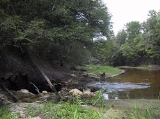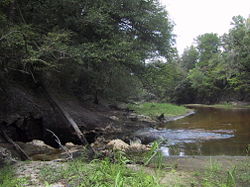
Surface water
Encyclopedia

Water
Water is a chemical substance with the chemical formula H2O. A water molecule contains one oxygen and two hydrogen atoms connected by covalent bonds. Water is a liquid at ambient conditions, but it often co-exists on Earth with its solid state, ice, and gaseous state . Water also exists in a...
collecting on the ground or in a stream
Stream
A stream is a body of water with a current, confined within a bed and stream banks. Depending on its locale or certain characteristics, a stream may be referred to as a branch, brook, beck, burn, creek, "crick", gill , kill, lick, rill, river, syke, bayou, rivulet, streamage, wash, run or...
, river
River
A river is a natural watercourse, usually freshwater, flowing towards an ocean, a lake, a sea, or another river. In a few cases, a river simply flows into the ground or dries up completely before reaching another body of water. Small rivers may also be called by several other names, including...
, lake
Lake
A lake is a body of relatively still fresh or salt water of considerable size, localized in a basin, that is surrounded by land. Lakes are inland and not part of the ocean and therefore are distinct from lagoons, and are larger and deeper than ponds. Lakes can be contrasted with rivers or streams,...
, wetland
Wetland
A wetland is an area of land whose soil is saturated with water either permanently or seasonally. Wetlands are categorised by their characteristic vegetation, which is adapted to these unique soil conditions....
, or ocean
Ocean
An ocean is a major body of saline water, and a principal component of the hydrosphere. Approximately 71% of the Earth's surface is covered by ocean, a continuous body of water that is customarily divided into several principal oceans and smaller seas.More than half of this area is over 3,000...
; it is related to water collecting as groundwater
Groundwater
Groundwater is water located beneath the ground surface in soil pore spaces and in the fractures of rock formations. A unit of rock or an unconsolidated deposit is called an aquifer when it can yield a usable quantity of water. The depth at which soil pore spaces or fractures and voids in rock...
or atmospheric water
Cloud
A cloud is a visible mass of liquid droplets or frozen crystals made of water and/or various chemicals suspended in the atmosphere above the surface of a planetary body. They are also known as aerosols. Clouds in Earth's atmosphere are studied in the cloud physics branch of meteorology...
.
Surface water is naturally replenished by precipitation
Precipitation (meteorology)
In meteorology, precipitation In meteorology, precipitation In meteorology, precipitation (also known as one of the classes of hydrometeors, which are atmospheric water phenomena is any product of the condensation of atmospheric water vapor that falls under gravity. The main forms of precipitation...
and naturally lost through discharge to evaporation
Evaporation
Evaporation is a type of vaporization of a liquid that occurs only on the surface of a liquid. The other type of vaporization is boiling, which, instead, occurs on the entire mass of the liquid....
and sub-surface seepage into the ground. Although there are other sources of groundwater, such as connate water and magmatic water
Magmatic water
Magmatic water or juvenile water is water which exists within and in equilibrium with a magma or water rich volatile fluids which are derived from a magma. This magmatic water is released to the atmosphere during a volcanic eruption...
, precipitation is the major one and groundwater originated in this way is called meteoric water
Meteoric water
Meteoric water is a hydrologic term of long standing for water in the ground which originates from precipitation. This includes water from lakes, rivers, and icemelts, which all originate from precipitation indirectly.- Overview :...
.
Classification of surface water quality
The field of hydrometryHydrometry
Hydrometry is the monitoring of the components of the hydrological cycle including rainfall, groundwater characteristics, as well as water quality and flow characteristics of surface waters...
is used to characterize surface water quality:
- Class 1 is extra clean fresh surface water resource used for conservation, not necessarily required to pass through water treatment process, and requiring only an ordinary process for pathogenic destruction and ecosystem conservation where basic organisms can breed naturally.
- Class 2 is very clean fresh surface water resource used for consumption, which requires ordinary water treatment process before use, for aquatic organism of conservation, fisheries, and recreation.
- Class 3 is medium clean fresh surface water resource used for consumption, but requires passing through an ordinary treatment process before use, for agriculture.
- Class 4 is fairly clean fresh surface water resource used for consumption, but requires a special water treatment process before use, for industry.
- Class 5 is the source which is not classified in class 1-4 and used only for navigation.
Definition: Surface water is taken from the lakes, rivers, waterfalls and sea.
Conjunctive use of ground and surface water
Surface and ground water are two separate entities, so they must be regarded as such. However, there is an ever-increasing need for management of the two as they are part of an interrelated system that is paramount when the demand for water exceeds the available supply (Fetter 464). Depletion of surface and ground water sources for public consumption (including industrial, commercial, and residential) is caused by over-pumping. AquiferAquifer
An aquifer is a wet underground layer of water-bearing permeable rock or unconsolidated materials from which groundwater can be usefully extracted using a water well. The study of water flow in aquifers and the characterization of aquifers is called hydrogeology...
s near river systems that are over-pumped have been known to deplete surface water sources as well. Research supporting this has been found in numerous water budgets for a multitude of cities.
Response times for an aquifer are long (Young & Bredehoeft 1972). However, a total ban on ground water usage during water recessions would allow surface water to better retain levels required for sustainable aquatic life. By reducing ground water pumping, the surface water supplies will be able to maintain their levels, as they recharge from direct precipitation
Precipitation (meteorology)
In meteorology, precipitation In meteorology, precipitation In meteorology, precipitation (also known as one of the classes of hydrometeors, which are atmospheric water phenomena is any product of the condensation of atmospheric water vapor that falls under gravity. The main forms of precipitation...
, runoff
Surface runoff
Surface runoff is the water flow that occurs when soil is infiltrated to full capacity and excess water from rain, meltwater, or other sources flows over the land. This is a major component of the water cycle. Runoff that occurs on surfaces before reaching a channel is also called a nonpoint source...
, etc.
See also
- MeltwaterMeltwaterMeltwater is the water released by the melting of snow or ice, including glacial ice and ice shelfs over oceans. Meltwater is often found in the ablation zone of glaciers, where the rate of snow cover is reducing...
- Optimum water content for tillageOptimum water content for tillageThe optimum water content for tillage is defined as the moisture content of soil at which tillage produces the largest number of small aggregates.-Overview:...
- Rainwater
- Environmental Persistent Pharmaceutical PollutantEnvironmental persistent pharmaceutical pollutantThe term Environmental Pharmaceutical Persistent Pollutant , was suggested in the nomination 2010 of pharmaceuticals and environment as an emerging issue to Strategic Approach to International Chemicals Management by the International Society of Doctors for the Environment .Pharmaceuticals are...
EPPP
Sources
- Applied Hydrogeology, Fourth Edition by C.W. Fetter.
- R.A. Young and J.D. Bredehoeft Digital simulation for solving management problems with conjunctive groundwater and surface water systems from Water Resources Research 8:533-56

